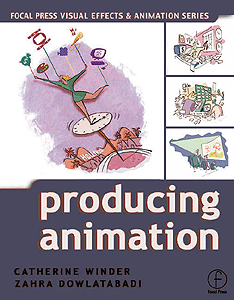This month's Producing Animation excerpt by Catherine Winder and Zahra Dowlatabadi features stories of advice from the pitching room!

Pitching
Let's assume you have managed to get in the door to pitch. The creative executive's goal is to determine whether your project is suitable for their studio. Since you need to establish an ongoing relationship with this person, be smart about the meeting. If this isn't the project for them, take the rejection gracefully. You want to leave a good impression so that they will want to see you again, at this job or their next, as executives tend to move around a lot. (It has been said that the average life of a creative executive at a studio is between one-and-a-half to three years.)
When pitching, try to remain as natural as possible. Analyze your audience's response and try to cater to what their needs are rather than taking the pitch in a direction that is suitable for you. Again, be short and to the point -- don't waste time. Summarize what you are selling and get the concept across in just a few sentences.
When I (Catherine) worked as a creative executive, I saw people make basic strategic errors. In one pitch, the creator was told in advance that we were looking for primetime content. We were assured that that was exactly what we would see. After everyone was introduced and we sat down to begin the usual small talk that takes place prior to a pitch, the creator stood up and commenced to sing and dance. This individual literally bounced around the room singing his heart out and sweating away for 30 minutes straight. It was impossible to cut in and ask a question. He performed an entire animated musical without a break. Since this project was suitable for a children's special, he had unfortunately wasted everyone's time, including his own. The next time he called to pitch a project, I chose not to hear his new idea since I was not sure what I would get and my time was very limited.
On another occasion, a seller brought 20 different projects to our meeting. The materials were placed in front of me, and like an auctioneer, this producer began to extol the merits of each rapidly, asking me to pick out the ones I wanted. In this case, she should have done her homework (researched our programming needs), selected the strongest concepts, and handed me one or at most three properties. Instead, she lost my attention within the first three minutes as I had little desire to sift through all the projects and figure out what was appropriate. There may have been a gem in the pile, but I had no urge or time to do her work for her and find it.
After a pitch, it generally takes time to get a response. Creative executives have many projects cross their desks each week. Consequently, it is almost impossible to get back to everyone in a timely manner. Unless you meet with the person who can greenlight optioning a property, the creative executive still needs to sell it to their superiors, who may want you to pitch the property again. They may also ask you to send more materials. You should thus expect to wait at least three to four weeks before hearing anything.
Catherine Winder has worked as both an executive producer in television and feature animation. Her background in development, as well as production with studios from around the world has given her a rare global expertise in the field of animation. In her present position as vice president production for Fox Feature Animation, she is overseeing production of the studio's 2D traditional and 3D CGI animated movies. She has co-written Producing Animation with Zahra Dowlatabadi.
Zahra Dowlatabadi, an award-winning producer, started her animation career in 1986. Since then, Dowlatabadi has worked in almost every major studio in Los Angeles along with many internationally acclaimed animation studios and talent. Dowlatabadi is the founder of an organization entitled Animation Team, which assists studios with production staffing needs ranging from qualified line producers to experienced production assistants. She also has co-written a book entitled Producing Animation with Catherine Winder for Focal Press.







